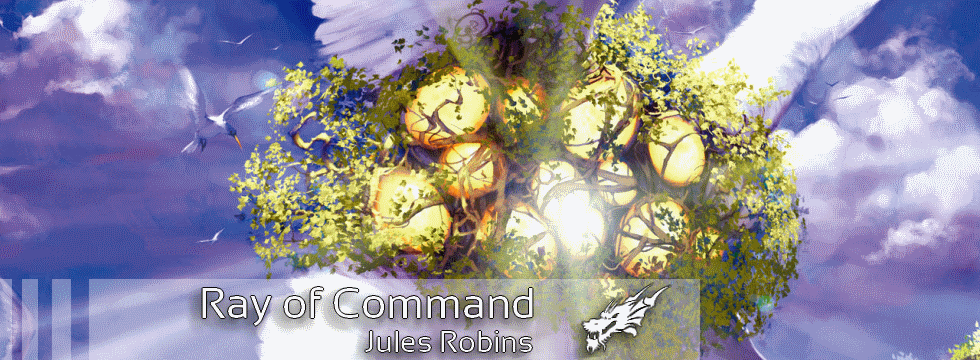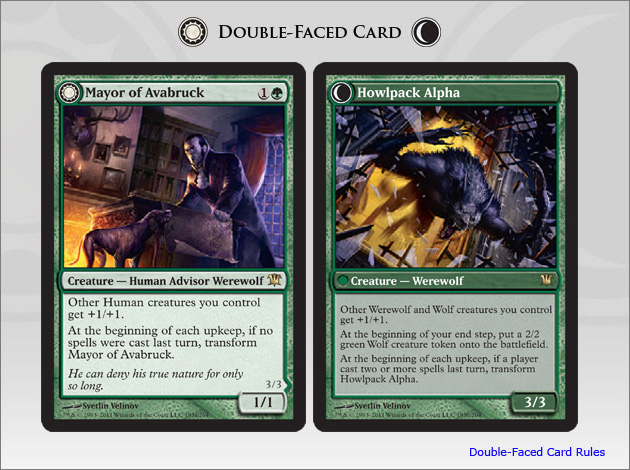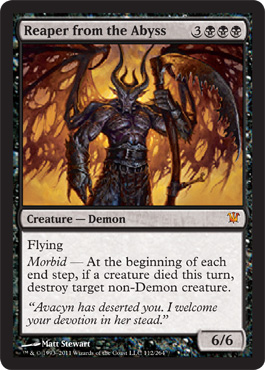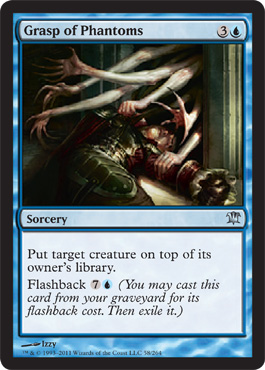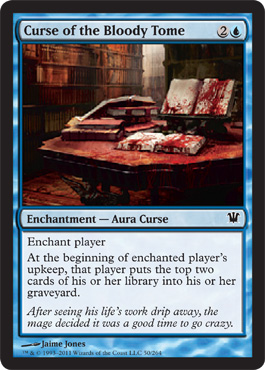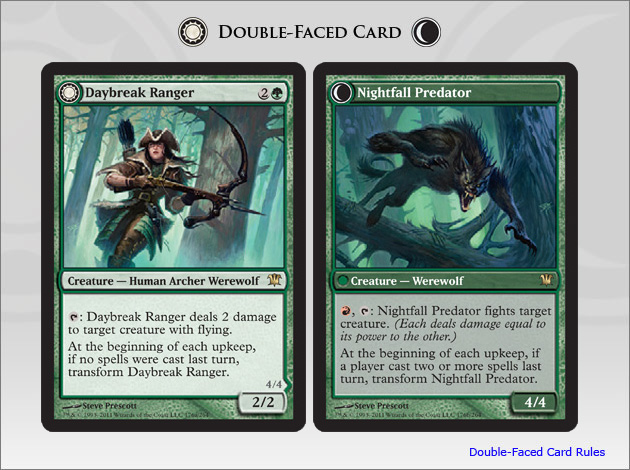Are you a Quiet Speculation member?
If not, now is a perfect time to join up! Our powerful tools, breaking-news analysis, and exclusive Discord channel will make sure you stay up to date and ahead of the curve.
I spent a recent weekend bravely running away from the irate Irene, and while sleeping on the floor at the airport wasn't my idea of a good time it did give me some time to think. When a new set is released, we as the Commander community usually have two interests. We want new cards that will enhance the decks we already have built, and we want cool new Legends to build around.
But every once in a while, something that a set brings really strikes our fancy and we create a deck based upon one of its mechanics. Go over and take a look at the MtG Salvation forums and see how many infect-based Glissa, the Traitor lists there are. Is Glissa a good commander for such a deck? Not particularly, but she's new and available, and mechanic based decks are usually the purview of new Commander players. That doesn't mean that more experienced players shouldn't build them. Sure, Commander is a place where you can play strategies you never could in regular Magic, but ultimately you're playing to have a good time, so if you really enjoy something you should go for it. Everyone has different preferences, so today I'm going to cover some of the best ways to build around our new mechanics and what I think of their design both in general and in the context of the Commander format.
Robots in Disguise
I guess we might as well start with the most controversial of topics: Double-Faced Cards. For those unaware, Innistrad will contain twenty cards that have no Magic card back. The front of the card is its day side, and under certain conditions you'll turn it over to the night side, a little something like this.
These play very similarly to Kamigawa's [card Nezumi Graverobber]flip cards[/card], but for those of us who aren't hard-core Melvins, feel is more important to game-play than function, and according to our friends over at Wizards, these feel different. I'm not sure if the benefits here are worth the confusion and logistical costs, but I'll reserve judgment until I've actually played with them.
Anyway, the more important question for this article is how to use these in Commander. They don't interact the way you'd want the to with Ixidron or Break Open, so until we see some more cards like Moonmist, there isn't much to be done with the card layout. That doesn't mean we should just ignore double-faced cards, after all, all of the red and green ones share a Human-to-Werewolf transformation. Our friends go hulk when an upkeep comes around after a spell-less turn, and change back when an upkeep comes after a turn where a single player cast two or more spells.
The immediately obvious route to go here is to make sure your opponents aren't casting any spells, but while [card Teferi, Mage of Zhalfir]Teferi[/card] with Omen Machine might keep everyone Wolfish, it's not going to be much fun for your opponents. Arcane Laboratory, Rule of Law, and Ethersworn Canonist aren't quite as mean and still help your Werewolf cause, though again there's a distinct lack of overlap in colors. Finally, there are some more subtle ways to help your shirtless actors.
Innistrad's Werewolves don't want you casting multiple spells most of the time, and at the start don't want you casting any, so you should pack a Werewolf deck full of expensive spells. More expensive spells are stronger in a game where you'll cast all of your spells anyway, but playing too many can put you so far behind on the board that you can't come back. Luckily Werewolves are undercosted creatures once you transform them, so they should be able to hold the fort while you're unable to cast your splashy spells, and then stay in form for the late game. Of course, there may be some that you want to change back. I'm not sure how much R&D has done with the concept, but in principle we could see Werewolves that punish you for a lack of spell-casting by turning into inferior creatures. If there were enough such designs, we'd instead want to fill a deck with cheap instants so as to get the benefits of a day side that wasn't meant to get an attack.
Screaming Metal Deathtrap
Next we come to Morbid, an ability word that gives you extra benefits if anything died on the turn in question.
Morbid makes a cool mirror to Magic 2012's Bloodthirst; against a deck featuring both you never know whether or not to block. That said, the mechanic's open-endedness makes it a lot better in Commander because with so many [card Wrath of God]Wrath[/card]s running around, you don't want to over-invest in your board position. Because creatures die pretty regularly, I doubt we'll see many Morbid triggers that are powerful enough to build around, but the strong cards should always be active in decks filled with [card Putrefy]removal[/card], [card Oblivion Stone]sweepers[/card], [card High Market]sacrifice outlets[/card], or [card Mulldrifter]suicidal creatures[/card]. Then again, you can always attack with Gigapedes until somebody blocks. From a design perspective I'm a bit concerned about a lack of splash, but then again you can do [card Sheoldred, Whispering One]just about anything[/card] for seven mana, so I suspect we'll see more cool mythics as the block progresses.
Trauma
Flashback is back, and as we've yet to see any innovations on the mechanic it's hard to make any recommendations other than sticking some in a graveyard deck.
Road Rage
Curses, like the [card Stone Idol Trap]Traps[/card] of Zendikar, are nothing special on their own, and I doubt you've seen any Trap decks running around your local Commander table. What'll be different here? Wizards is much more tuned-in to the Commander community now than they were two years ago, and I would bet that if Worldwake were released today it would have a legendary Ally. We can't be sure, but I wouldn't be surprised if we got a legendary Curse caster in this block. Even if we don't, Curses will at least let griefers who don't want to play [card Zur the Enchanter]Zur[/card] play enchantment based decks, and really, is there anything more you could ask for?
My bigger concern is the precedent that Wizards is setting here. Tribal is considered a failure by most of R&D, and Mark Rosewater has lamented bringing it back in Rise of the Eldrazi because it makes it look evergreen. Once tribal exists, people want every Goblin Assault to have the type, but if those were used every set, lots of cards would have a bunch of meaningless subtypes and might have to be costed higher for interactions in older formats, thus denying them Standard playability. Of course, making Zendikar's traps actual Traps made them cooler, but is it worth people wanting Pit Trap to be the same? For the two cards we got, I'd argue no. The Curse subtype could prove its worth, but until I see some compelling reasons for it, I'm not lending any support.
Drag Racers
Our next mechanic is not limited to Innistrad block, but rather a new evergreen keyword action: Fight.
Rivals' Duel now reads “Choose two target creatures that share no creature types. Those creatures fight.” I've always liked Arena effects, but more often than not they feel clunky, so I love the 'no frills' version. The only problem is that looking at it makes me wonder why [card Regenerate]Regeneration[/card] hasn't been changed into a simpler form.
As for Commander applications, the most important piece is that the creatures deal the damage, so [card Blight Sickle]Wither[/card], [card Phyresis]Infect[/card], Lifelink, and [card Gorgon Flail]Deathtouch[/card] all work superbly. Even better, if you can send Greatbow Doyen, Soul Collector, some one wearing Neko-Te, or anything [card Charisma]charismatic[/card] into a fight, you're likely to come out ahead. Of course, everything that works well with Fight is similarly good when blocking or being blocked (a major success for the mechanic), so I imagine any deck running Magus of the Arena and friends would be similarly happy to [card Krosan Vorine]Provoke[/card] the enemy. On that note, while similar abilities tend to be red, I could definitely see green using fight for removal more often and at lower rarities; it certainly feels better than Arachnus Web or Beast Within.
Honor Roll Bumper Stickers
And finally we come to some unknown mechanics: the tribes. Earlier I talked about a possible Werewolf deck, but we don't know as much about the mechanical ties that the rest of the tribes will have. Of course, a safe place to start when picking a tribe is to search for every card that references the subtype in its rules text, and some of Innistrad's tribes have a lot of backward compatibility. Zendikar block and the new line of Core Sets have given us a number of Vampires matter cards, and Ghosts have the entirety of Kamigawa block to draw upon. Zombies were well represented in Onslaught, and actually have helpers going back to Zombie Master in Alpha! Werewolves have it tougher, with only three members of the tribe and no tribal component, and Humanity is just now getting tribal effects, but we already have almost thirteen-hundred members. Then again, from the looks of things so far, it shouldn't be too hard to build a Human/Wolf/Werewolf tribal deck, so maybe Master of the Hunt and his [card Master of the Wild Hunt]wild side[/card] can step up to the plate. Besides, we always have Adaptive Automaton, Brass Herald, Door of Destinies, and Coat of Arms.
Parking It
While none of Innistrad's mechanics look quite as enticing as [card Throne of Geth]Proliferate[/card], it still brings some interesting options to the table. I, for one, am considering some type of Fighting based deck, and I certainly expect to be using Morbid spells all over the place. Others will, I'm sure, build some sweet tribal decks around the legendary monsters, and maybe one of you will dig up a brilliant idea I missed here. If so, give me a call at 1-888-CAR-TALK
This is NPR.
Jules Robins
julesdrobins@gmail.com/Google+
@JulesRobins on twitter


